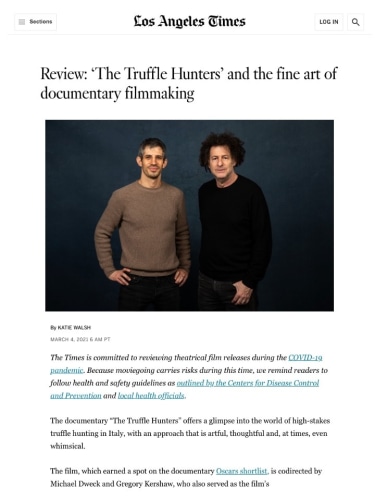Review: ‘The Truffle Hunters’ and the fine art of documentary filmmaking
Los Angeles Times
03/04/2021
Back
By Katie Walsh
The Times is committed to reviewing theatrical film releases during the COVID-19 pandemic. Because moviegoing carries risks during this time, we remind readers to follow health and safety guidelines as outlined by the Centers for Disease Control and Prevention and local health officials.
The documentary “The Truffle Hunters” offers a glimpse into the world of high-stakes truffle hunting in Italy, with an approach that is artful, thoughtful and, at times, even whimsical.
The film, which earned a spot on the documentary Oscars shortlist, is codirected by Michael Dweck and Gregory Kershaw, who also served as the film’s cinematographers. The pair previously collaborated on Dweck’s 2018 film “The Last Race,” a tribute to Long Island’s last stock car race track, which becomes an almost abstract cinematic exploration of rumbling diesel engines and exhaust fumes.
On the surface, it would seem that “The Truffle Hunters” couldn’t be further from “The Last Race,” in mood, style and tone. But Dweck and Kershaw have a fascination with, and urge to capture on film, ways of life that are on the brink of extinction. In both “The Last Race” and “The Truffle Hunters,” they utilize a studied observational style to explore what seems to be the last moments of a grand cultural tradition, without overt judgment or hand-wringing, just quiet reverence for the way things were, and still are, at this moment in time.
The film follows four Italian men, truffle hunters in their 70s and 80s as well as their beloved dogs. They’re addicted to the hunt, tramping about the forest floor of Piedmont, Italy, in search of buried treasure: the elusive fungi known as the white truffle, which can go for a pretty penny, especially at high-priced auctions. This humble-looking, aromatic mushroom isn’t just a delicacy for gourmands and foodies, it’s a decadent status symbol, shaved table side, elevating a humble bowl of pasta or an egg to a food of the gods. It cannot be cultivated, and as the prices rise, the truffle hunt escalates.
Yet the film mostly resists the drama, choosing instead to focus on these four men who symbolize the way things used to be: just men and their dogs in the forest. The film is told in mini-narrative arcs for each character. The 88-year-old Carlo refuses to stop hunting at night, despite injury, even with his wife hectoring him to stay home. Aurelio is on a quest to find someone to care for his precious pup Birba after he’s gone. Sergio, a rock drummer, hunts frequently with his dogs, worrying that they’ll ingest poison. And the long-haired Angelo, a former circus acrobat, has given up the hunting lifestyle in a huff, clacking away at a typewriter, writing a manifesto of sorts as to how greed has corrupted the pursuit.
The aesthetic approach is distinctive and striking. Kershaw and Dweck compose gorgeous static shots, each image as perfectly lit as a Caravaggio painting, chiaroscuro shadows offering visual drama and dynamism. Within these painterly images, conversations and action unfold. One enterprising truffle dealer seems to conduct all of his transactions in dark alleyways, lit by headlights or lamplight spilling from a nearby window. The only time the film diverges from these exquisite compositions is to give the audience a dog’s-eye view of the hunt, with a camera strapped to a dog’s head as they sniff and dig for treasure.
The result is a film that lies at the intersection of documentary, Italian neorealism and Renaissance painting, a wholly singular visual experience that is inextricably tied to the film’s storytelling. Pioneer documentarian John Grierson defined documentary filmmaking as “the creative treatment of actuality,” and “The Truffle Hunters” is one of the finest and most unique examples of that ethos on screens this year, a cinematic delicacy as rare as the truffle itself.
Katie Walsh is a Tribune News Service film critic.
‘The Truffle Hunters’
In Italian with English subtitles
Rated: PG-13 for some strong language
Running time: 1 hour, 24 minutes
Playing: Starts March 5, Vineland Drive-in, City of Industry; and in limited release where theaters are open